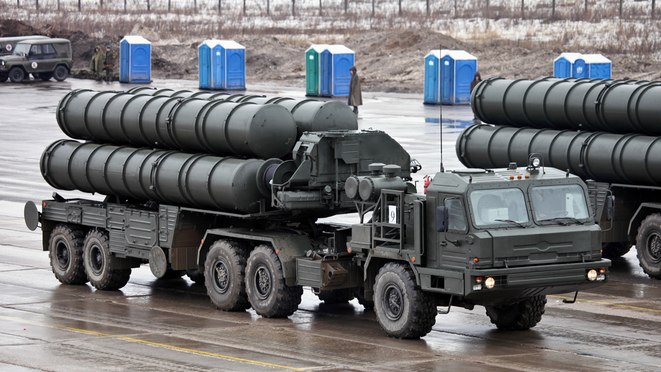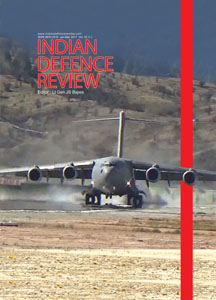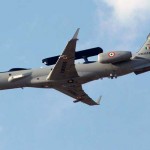Russia expects a $4.5 billion commercial contract to be signed by the middle of 2017…
What appeared to be just a possibility of getting the S-400 was converted into a reality when “India and Russia signed an inter-governmental agreement for the procurement of four (some sources say five) regiments of Russian-made S-400 Triumf advanced Air Defence Systems on October 15, 2016 in Goa at the sidelines of the eighth BRICS summit. The deal, along with 17 other cooperation agreements, was signed in the presence of Prime Minister Modi and President Vladimir Putin.11
The head of the Russian state-owned defence and technology conglomerate Rostec, Sergey Chemezov, told reporters that “An intergovernmental agreement has been signed under which the Russia has undertaken to deliver S-400 to India.” Russia expects a $4.5 billion commercial contract to be signed by the middle of 2017. “We will then start preparing the contracts and I hope that in the first half of 2017 we will complete and sign these contracts and the production will start. I believe the delivery will begin somewhere in 2020,” Chemezov added.12
What Does S-400 do for India?
An analysis of the characteristics of S-400 stated earlier puts India in the exclusive group of nations which can provide very high altitude and fairly long range protection to a given part of the national airspace. While the ink on the agreement signed in Goa has not even dried and a commercial contract some time away, the consequences for India acquiring the system are engaging widespread attention along with the repercussions for the affected adversaries. Some of these analyses can be very instructive for students of air defence.
The S-400 would virtually cover most of Pakistan which means Pakistani fighters would become extremely vulnerable…
According to Bilal Khan writing for Quwa, “One would assume that India has every incentive to station a number of S-400 systems – potentially up to three – in fairly close proximity to Pakistan. If equipped with the 40N6 missile, grounding the S-400 in the heart of Indian Punjab would enable India to stifle the Pakistan Air Force (PAF) from flying in key areas in its Central Command theatre which is responsible for protecting Lahore, the country’s inland economic hub and second largest city. Similar positioning and results can be had in the South in terms of Karachi and the north in terms of Kashmir. India need not deploy the S-400 in that manner at least permanently, though the incentive to pre-empt Pakistan from utilising its aerial assets which carry a number of the country’s pre-emptive stand-off range munitions, is certainly there and should not be dismissed. In fact, the risk of India adopting such a course is something Pakistani defence planners would be wise to acknowledge and work to address. Moreover, India’s other air defence investments e.g. Barak, provide it with ample opportunity to build medium-to-long range SAM applications for more conservative air defence deployments.”13
According to Pranab Dhal writing for ET Bureau, “The S-400 would virtually cover most of Pakistan which means Pakistani fighters would become extremely vulnerable, tilting all battlefield equations against the PAF. India plans to deploy three of these against Pakistan and two against China, one each on the Western and Eastern sectors of the Line of Actual Control (LAC). The calculus is that even the Chinese would have to depend largely on their aerial capabilities for any deep offensive into India. So, this acts as a major deterrent. Interestingly, the Chinese are also buying six S-400 systems from Russia. But Beijing’s plans are to deploy these largely against any US-led thrust. In many ways, this system could end up reconfiguring the deterrent matrix in the region over a period of time. But strictly from an Indian context, the spin-offs on strategic decision making would be almost immediate, one that will provide more latitude and security to the political authority, at least on the volatile Pakistan front.14
It would be apparent from the foregoing that India has initiated adequate steps to acquire an exceptional ground-based air defence weapon system which will place its adversaries at a disadvantage. We, however, still need to address the other matter of deleting some planned acquisitions from the long term acquisition plans. It is important to know that, “The S-400 can not only block enemy aircraft from providing support to their army during a conventional war, it can provide an umbrella against Pakistani or Chinese missiles in case of a nuclear war. The missile system is, therefore, a force multiplier that can dramatically influence the outcome of a war. However, no single missile is a game changer on its own. Missile defence works best when it is layered – multiple systems covering low, medium and high altitudes. Anti-Aircraft Artillery (AAA) and air defence aircraft are also vital links of this network. Countries that successfully integrate this multi-tier, multi-pronged system can significantly increase the costs for attacking air forces.15
It is a widely known fact that the inventory of Indian Army’s ground-based air defence is mostly obsolete…
Air Defence Architecture and Depletion of Planned Acquisitions
Having established the status of S-400 as a weapon par excellence, we need to revert to discover the manner in which air defence protection is organised and why we need to acquire a wide array of systems to destroy the threat and cancelling planned acquisitions of different types of weapon systems may result in a short term financial advantage with long term adverse effects. Before proceeding further there are some basic issues, which must be identified.
Present State of Ground-Based Air Defence
It is a widely known fact that the inventory of Indian Army’s ground-based air defence is mostly obsolete. While not commenting on the other services, suffice it to say the Indian air defence may not be in a position to counter a modern 21st century aerial threat. This is the time to acquire, at least a part of the requirement, off-the-shelf, ready-to-shoot weapons. The stage for finding solace in endlessly waiting for systems on the drawing board or upgrading old systems, may be fast running out. Ground-based air defence of Indian armed forces needs modernisation in large numbers and now.
The Modern Aerial Threat
Modern aerial threat would consist of fighter aircraft, helicopters, unmanned aerial systems, both armed and unarmed, ballistic missiles, rockets, artillery shells and mortar bombs – all in large numbers. These threats moving unhindered have innumerable options in terms of time, direction, altitude and numbers to approach and strike targets in our territory. Each one of these threat elements will be detected, identified as hostile and the most suitable system assigned to engage and destroy the threat. Some of these threat elements will escape early detection or will simply reach critical assets because the long range weapons are already engaging the detected threat. This is especially important for the protection of army assets, in the tactical battle area, undertaking offensive operations beyond our borders.
Successful conduct of air defence battle in the 21st century will be a critical factor in success…
Need for a Multi-Capability Missile-Based Destructive Air Defence System
It needs to be emphasized that for the successful conduct of air defence battle to effectively protect the airspace as well as critical assets, we need to create a weapon mix of multi-tiered, ground-based, destructive air defence systems which:
- Will provide a ‘cost effective’ response to any threat in relation to its destructive potential.
- Will not be inundated by a variety of hostile aerial objectives, which nearly simultaneously enter our airspace.
- Will protect all ground-based critical assets to which threat has been appreciated, located ‘anywhere’ in the country including some of the coastal assets as well as the tactical battle space and assaulting formations undertaking offensive in enemy territory.
- Will effectively relieve the IAF of air defence duties and depending on the battle situations, which preclude any potential conflict situations, to completely sanitise a given segment of the airspace of any enemy air activity e.g. over the tactical battle area.
The above mentioned multi-tiered, destructive, ground-based air defence system will need a number of different types of weapons arrayed in a capability-based air defence architecture, which will protect national airspace, in co-ordination with the IAF as specified or whenever an opportunity arises and protect critical assets when threatened by a very intense, modern air threat.
The ever-changing nature of a dynamic modern air threat calls for a modern inventory of fighter aircraft as well as ground-based air defence weapons…
This architecture, which also defines the role of any given weapon system, will comprise the following:-
- Long Range Air Defence Missiles with ranges over 100 km.
- Medium Range Air Defence Missiles with ranges up to 60 km.
- Short Range Air Defence Missiles with ranges up to 30 km.
- Close Defence Protection Air Defence Missiles with range up to 10 km.
- Close defence Protection Air Defence Guns with ranges over 4 km
While we have earlier established the pre-eminence of S-400 as a ground-based air defence weapon system, yet when viewed against the background of need to have a complete architecture of weapons with different capabilities to counter a very dynamic, ever changing aerial threat, this weapon is just another primarily a long range ground-based air defence weapon albeit with some war-winning capabilities. It can replace only some long range air defence weapon and no other constituent of the architecture.
Conclusion
Successful conduct of air defence battle in the 21st century will be a critical factor in success. The ever-changing nature of a dynamic modern air threat calls for a modern inventory of fighter aircraft as well as ground-based air defence weapons. Conduct of air defence battle will call for engagement of aerial threat over a large area. Threat elements with varying characteristics spread over in time and space, will need to be detected, identified as hostile and engaged with the most suitable weapon system available in the area where the critical asset is located.
The proposed acquisition of the S-400 will undoubtedly impact adversary capability in conducting air operations and will be a valuable constituent of the air defence architecture. It is expected to enter service by 2020 and may complete induction in five to six years. The system has a place in the architecture along with other systems required to safeguard the air space. This system will create the desired advantage only as part of the architecture.
The air defence inventory of the nation consisting of obsolete or obsolescent systems is in need of complete modernisation. Any attempt at cancelling plans to acquire weapons because we are acquiring S-400, to save money is like creating a chimera. There may be a price to pay later.
Notes
- Manu Pubby, ET Bureau | 12 Mar, 2016, 04.00AM IST.
- Wikipedia.
- Timothy R. Heath, How China’s New Air Defense System Could Change Asia, The RAND Blog, January 21, 2016 C.
- Rakesh Krishnan Simha, India Is Building A Missile Defence System – With Russian Missiles! – Nov 08, 2015, 10:57 pm.
- Timothy R. Heath Op cit.
- Rakesh Krishnan Simha How Russia’s S-400 makes the F-35 obsolete,11 March 2015.
- The Hindu, NEW DELHI, Updated: December 18, 2015 02:41 IST.
- Ibid.
- Modi, Putin hail partnership but silent on S-400, Dec 25, 2015 00:50 IST.
- India, Russia negotiating sale of S-400 missiles to India: Russian envoy, February 12, 2016 By Aditya Bhat; (Internet).
- India and Russia Ink S-400 Missile Air Defense System Deal By Franz-Stefan Gady, The Diplomat October 20, 2016.
- Ibid.
- Bilal Khan, Daily Views, Oct 18, 2016,THE IMPACT OF INDIA’S S-400 PURCHASE Quwa Defence News and Analysis Group.
- Pranab Dhal Samanta, Russian S-400 Triumf gives India an edge against Pakistan, China ET Bureau | Updated: Oct 17, 2016, 12.44 PM IST.
- Rakesh Krishna Simha, Op cit.







Good analysis.
S-400 is indeed need of IAF
Absolutely. We just canr not have s400 as a replacement of od a layer based air defence. You dont use s400 to shoot down an F16 or jf17. It is like using using MBRL to kill 1 enemy soldier. So u need to have appropriate air defence weapon for different threats.